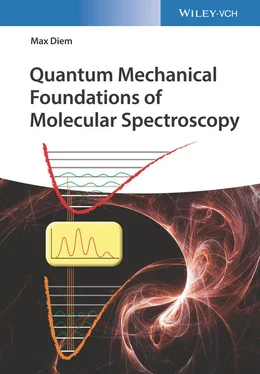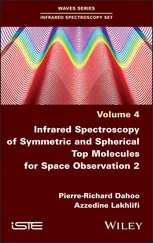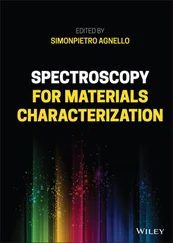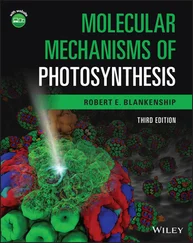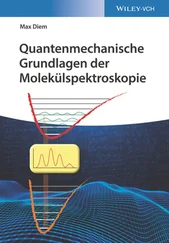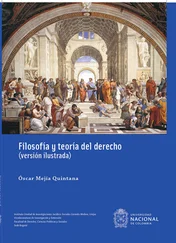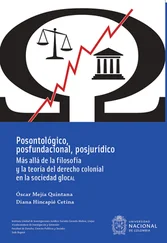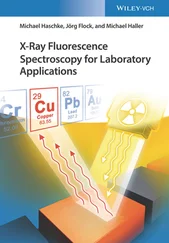The following chapters are presented in order of mathematical complexity of the Schrödinger equation that describes the problem. The simplest case, the particle in a box, is discussed in Chapter 2. The next subject is the simple harmonic oscillator, for which the eigenfunctions resemble those of the particle in a box, and transitions can be visualized in terms of the discussion in Chapters 2and 3. In the following discussions ( Chapters 5– 10), vibrational, rotational, atomic, molecular electronic, and spin spectroscopies will be introduced. These discussions, if possible, start with a classical description, followed by the quantum mechanical equations for wavefunctions and eigenvalues, and the derivation of the selection rules. These selection rules determine the form and information content of the respective spectroscopic techniques. Although space limitations prevent in‐depth discussions of spectroscopic applications to complex molecular systems, all efforts have been made to include molecular systems larger than diatomic molecules (the level of molecular complexity where many textbooks capitulate), since the world we live in mostly consists of more complicated molecules than diatomics.
Thus, in Chapter 5, the concept of the harmonic oscillator ( Chapter 4) will be extended to vibrational (infrared and Raman) spectroscopy of polyatomic molecules. This chapter introduces concepts of band shapes, lifetimes, and a quantum mechanical description of molecular polarizability. Next in complexity are the differential equations for a rotational molecule that leads to rotational spectroscopy ( Chapter 6). These equations will introduce the quantum mechanical description of the angular momentum and the energy levels of simple and more complicated molecules. The results from the rotational Schrödinger will also be used to solve the radial part of the hydrogen atom Schrödinger equation ( Chapter 7). The principles learned from the rotational Schrödinger equation will also be used to introduce the spin eigenfunctions and eigenstates, a subject that leads directly to spin spectroscopy such as nuclear magnetic resonance (NMR), which is discussed in Chapter 8.
Next, the structure of atoms and ions containing more than one electron will be presented. This discussion includes an introduction to atomic spectroscopy and term symbols of electronic states. However, since the main theme of this book is molecular spectroscopy, this chapter only serves as an introduction to these subjects.
Chapter 10is devoted to electronic spectroscopy of di‐ and polyatomic molecules. Again, as in previous chapters, it is necessary to define the states between which electronic transitions occur. This leads necessarily to the discussion of chemical bonding in terms of molecular orbital theory. Chemical bonding will be discussed to the level that electronic spectra of simple molecules can be explained, but the interaction between vibrational and electronic wavefunctions to produce vibronic states will be discussed in more detail to explain fluorescence phenomena as well as some Raman effects that rely on transitions into vibronic energy levels. Finally, Chapter 11introduces group theory and the symmetry properties of molecules and the influence of symmetry on the appearance of molecular spectra.
The approach taken here in this book was strongly influenced by an excellent textbook Physical Chemistry by Engel and Reid [1] that was used as a required text in undergraduate physical chemistry courses at Northeastern University. This book emphasizes the unconventional approach taken by the early theorists who are responsible for the field of quantum mechanics as we know it. I gained substantial understanding of the philosophical background of quantum mechanics from this book. What is presented here in Quantum Mechanical Foundations of Molecular Spectroscopy is a similar approach but with much more emphasis on molecular spectroscopy.
Although the present book emphasizes the relationship between spectroscopy and quantum mechanics more than other texts, the author wishes to point out the importance of following up on some proofs and derivations (omitted here) by studying books on “real” quantum mechanics or quantum chemistry. In particular, the one‐ and two‐volume treatments by I. Levine [2, 3] are highly recommended, as well as many other old and new books [4, 5].
The mathematical requirements for understanding this book do not exceed the level achieved after a three‐semester sequence of calculus, and all efforts have been made to provide examples and problems that will illuminate the mathematical steps. Most importantly, although some derivations are presented, the goal is not to lose sight of what quantum mechanics does for spectroscopy in the mathematical complexities.
Boston, August 2019
Literature references for the Preface are at the end of the Introduction.
This book, Quantum Mechanical Foundations of Molecular Spectroscopy , is based on a graduate‐level course by the same name that is being offered to first‐year graduate students in chemistry at the Department of Chemistry and Chemical Biology at Northeastern University in Boston. When I joined the faculty there in 2005, I revised the course syllabus to emphasize the philosophical underpinnings of quantum mechanics and introduce much more of the quantum mechanics of molecular spectroscopy, rather than atomic structure, chemical bonding, and what is commonly referred to as “quantum chemistry.”
As my own appreciation of many aspects of quantum mechanics evolved, I found it useful to start my lectures in this course with a quote from a famous researcher and Nobel laureate (1995, for his work on quantum electrodynamics), the late Professor Richard Feynman, which – taken slightly out of context – reads [6]:
I think I can safely say that nobody understands quantum mechanics.
This rather discouraging statement has to be seen from the viewpoint that, when studying quantum mechanics, one realizes that this theory is not based on axioms, but on postulates – a very unusual fact in the sciences. Furthermore, it replaced deterministic results with probabilistic answers. When exposed to these conundrums, students will naturally ask the question: “Why bother studying quantum mechanics, if I will not understand it anyway?” or worse, “Is quantum mechanics for real, or is it the brainchild of some far‐out mad scientists?” The answer here is also contained in a quote by Feynman:
It doesn't matter how beautiful a theory is, …. If it doesn't agree with experiment, it's wrong.
This statement could also be formulated to imply that a theory that consistently provides answers that agree with the experiment most likely is correct. Thus, although nobody may understand quantum mechanics in its entirety, it gives answers that – over and over – agree with experiments and in fact provides a mechanism and framework for explaining the experimental results.
Quantum mechanics originated in the early decades of the twentieth century, when it was found that some experiment results just could not be explained by existing laws of physics and, in fact, violated established physical dogmas. It was these results that gave rise to the emergence of quantum mechanics that grew out of a patchwork of ideas aimed at explaining these hitherto unexplainable experimental results. These ideas coalesced into the field we now refer to as quantum mechanics. This newly formulated theory was wildly successful in explaining a myriad of physical and chemical observations – from the shape and meaning of the periodic chart of elements to the subject of this book, namely, the interaction of light with matter that is the basis of spectroscopy.
While many aspects of molecular spectroscopy, such as the rotational or vibrational energies of a molecule, can be described in classical terms, the idea that atoms and molecules can exist in quantized, stationary energy states is a direct result of the postulates of quantum mechanics. Furthermore, application of the principles of time‐dependent quantum mechanics explains how electromagnetic radiation of the correct energy may cause a transition between these stationary energy states and produce observable spectra. Thus, the entire field of molecular spectroscopy is a direct result of quantum mechanics and represents the experimental results that confirms the theory. The phenomenal growth of all forms of spectroscopy over the past eight decades has contributed enormously to our understanding of molecular structure and properties. What started as simple molecular spectroscopy such as infrared and Raman vibrational spectroscopy, (microwave) rotational spectroscopy, ultraviolet–visible absorption, and emission spectroscopy has now bloomed into a very broad field that includes, for example, the modern magnetic resonance techniques (including medical magnetic resonance imaging); nonlinear, laser, and fiber‐based spectroscopy; surface and surface‐enhanced spectroscopy; pico‐ and femtosecond time‐resolved spectroscopy, and many more. Spectroscopy is embedded as a major component in material science, chemistry, physics, and biology and other branches of scientific and engineering endeavors. Thus, the quantum mechanical underpinnings of spectroscopy are a major subject that need to be understood in the pursuit of scientific efforts.
Читать дальше
